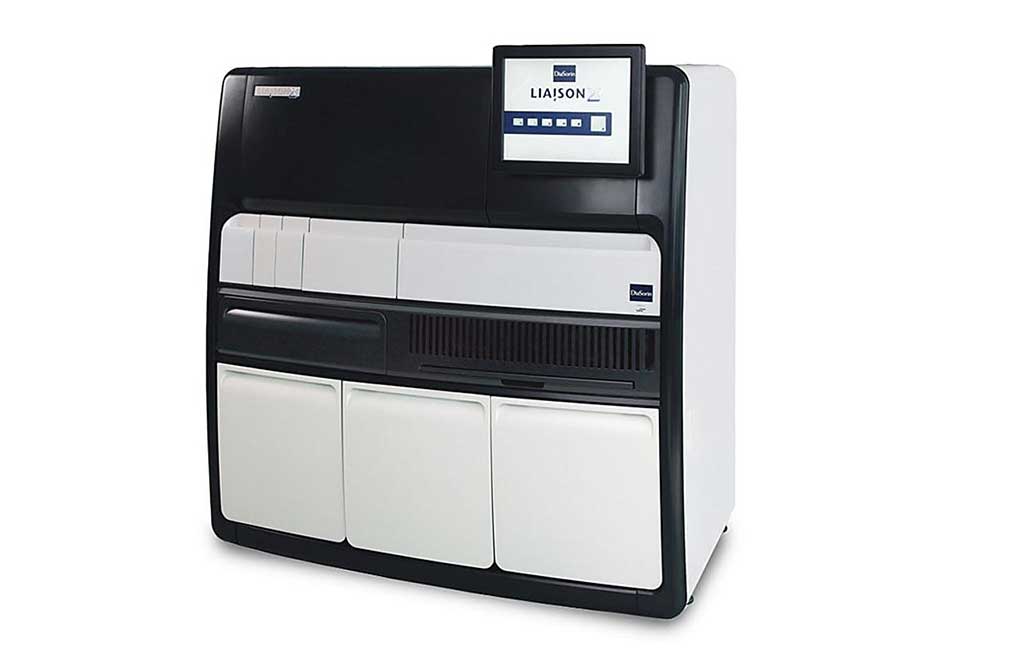Serum Thyroglobulin Assays Compared for Differentiated Thyroid Carcinoma
By LabMedica International staff writers
Posted on 05 Oct 2020
Measurement of serum thyroglobulin (Tg) plays a key role in the post‐thyroidectomy management of differentiated thyroid carcinoma (DTC). In this context, the performance of new‐generation thyroglobulin assay has clinical implications in the follow‐up of DTC patients.Posted on 05 Oct 2020
Following total thyroidectomy, serum Tg levels are expected to be undetectable. On this basis, postoperative circulating Tg levels are used as a tumor marker to assess completely surgical resection and recurrence in the follow‐up of well‐differentiated thyroid cancer (DTC). The addition of Tg concentration of fine‐needle washouts (FNA‐Tg) of the suspicious lymph node to fine‐needle aspiration cytology (FNAC) showed improved prediction of lymph node metastases (LNM).

Image: LIAISON XL is a fully automated chemiluminescence analyzer, performing complete sample processing as well as measurement and evaluation (Photo courtesy of Diasorin).
Medical Scientists at the University of Naples “Federico II” (Naples, Italy) selected a total of 91 residual serum samples between September 2019 and December 2019. These subjects comprised 35 men and 56 women, and their mean age was 48.2 ± 17.0 years. Serum postsurgical Tg lower than 1‐2 ng/mL is a strong predictor of remission, whereas Tg levels more than 10‐30 ng/mL are associated with persistent or recurrent disease. Study samples were from 21 patients with pathologically proven DTC and control samples from 70 (16 patients with benign thyroid disease and 54 apparently healthy subjects).
Tg was determined by using two different chemiluminescence immunoassays (CLIA). Specifically, these included Liaison (Tg-L, Liaison XL, Diasorin, Saluggia, Italy) and Beckman UniCeL DxI800 (Tg-A, Access, Beckman Coulter Inc, Brea, CA, USA). Thyroglobulin antibodies (TgAbs) were determined by Siemens ADVIA Centaur (Siemens Healthcare Diagnostics Products Ltd., Llanberis, UK).
The investigators reported that the results showed that Tg‐L was highly correlated with Tg‐A for both values ranging between 0.2 and 50 ng/mL) and higher than 50 ng/mL. For Tg values lower than 0.2 ng/mL, the overall concordance rate was 92%. Moreover, they tested seven fine‐needle aspiration washout fluids (FNA), showing an overall concordance rate in discriminating negative and positive of 100%. Finally, they found no interference by Tg auto‐antibodies (TgAbs) for both Tg‐L and Tg‐A. Conversely, rheumatoid factor (RF) interferes with Tg‐A, but not with Tg‐L in one patient with no relapsing thyroid carcinoma.
The authors concluded that preliminary data on a small study population suggests a good correlation between Liaison Tg II assay and the well‐established Access immunoassay. Further studies on larger population are needed to confirm the findings and to evaluate the clinical performance of this new immunoassay in the follow‐up of DTC patients. The study was published on September 20, 2020 in the Journal of Clinical Laboratory Analysis.














